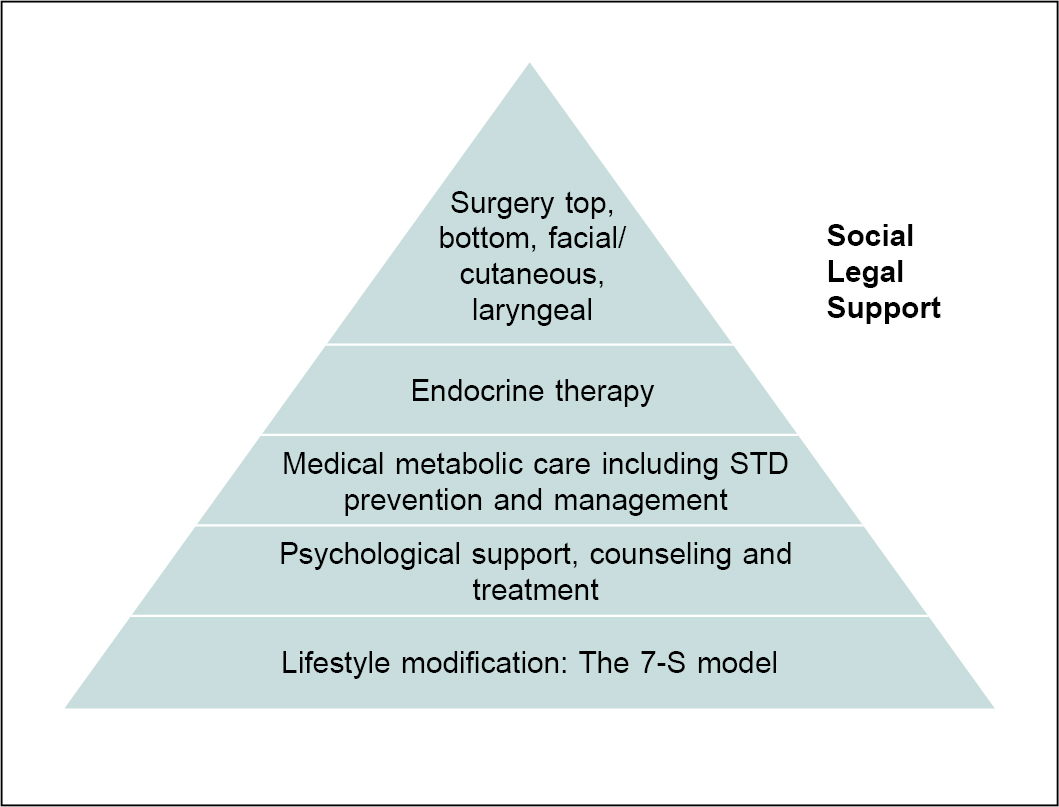https://doi.org/10.59793/ijcp.v34i2.458
Abstract
Transgender care needs a multidisciplinary team approach. The awareness about transgender health has increased over the past few years in India. The pyramid of transgender health helps to demystify the care of transgender individuals. The 7 S's of lifestyle modification need to be followed in the routine clinical care of transgender individuals. The individuals also need psychological care and support, metabolic and medical care, endocrine management, and later surgery in some cases. The policy makers can use the pyramid to decide about financial help to the community for their holistic care. The physicians involved in the care of transgender individuals can also take guidance about comprehensive care and management of transgender and gender diverse individuals.
Keywords: Transgender health, gender diversity, gender affirmation, hormone therapy
Transgender health is a complex multidimensional topic, which requires inputs from various clinical, as well as non-clinical disciplines. In recent years, transgender health has become more visible in India. Though the number is still inadequate, many health care systems now offer comprehensive health services to the transgender community. It does become daunting, however, to start a green-field transgender health service, or to begin integrating transgender health into pre-existing health care systems. We propose a pyramid of transgender health therapeutics, which can be used as a template by health care professionals, planners, policymakers and payers, to address this challenge. This model helps ‘demystify’ transgender health, and allows addressal of various health needs in a step-wise manner. It will also assist planners and policymakers in ensuring efficient coverage of the marginalized transgender persons and gender diverse community. Payers, such as insurance companies and government- funded schemes, can use this pyramid to streamline transgender health care delivery (Fig. 1). The base of the pyramid, for transgender health and for all chronic health care, is lifestyle modification. This includes the 7 S’s, as elucidated in Table 1. These should be integrated and offered at all levels of health care, from primary upwards.

Figure 1. The Pyramid of transgender therapeutics.
|
Table 1. The 7 S’s of Lifestyle Modification: Primary Care for Transgender Persons
|
|
Sensible sustenance (diet)
|
|
Structured physical activity (exercise)
|
|
Stress management (psychological first aid)
|
|
Sleep hygiene
|
|
Substance abuse avoidance
|
|
Safe and sage sex practices
|
|
Social support
|
In transgender and gender diverse individuals, this advice should be linked with pragmatic psychological support, counseling and treatment. Psychological first aid is a useful concept which finds traction in emergency situations. However, similar aid is needed by many transgender persons seeking health care. All health care providers should be skilled at offering such support. Persons who require more in-depth psychological care may be referred to a mental health professional. Infection (sexually transmitted disease or STD) prevention and treatment, as well as metabolic care, is an important part of transgender medicine. Such interventions should be offered at the secondary health care level, and also at the primary care level, if possible.
Endocrine interventions, including gender affirmative hormonal therapy (GAHT) should be available at all endocrine tertiary care institutions. However, services may not exist in all centers, or may be over worked because of the heavy burden of endocrine and metabolic illness. Therefore, it makes sense to create centers of excellence across the country, which can provide not only endocrine, but surgical support as well. Primary and secondary care physicians need to be aware of side effects of GAHT and monitor general and cardiometabolic health and seek timely referral.
Regular oncology monitoring as per guidelines, at secondary and tertiary care level should not be overlooked. Transgender surgery is a complex field, which includes top surgery, bottom surgery/Laser and laryngeal modification. This forms the apex of the pyramid of transgender therapeutics.
SUMMARY
The model that we propose offers a simple, yet robust method of integrating health care provision. A family-centric and family-strengthening systemic approach, which seeks to normalize/depathologise diversity and nonconformity by listening to and learning from the lived experience of the individual, provides care tailored to the needs of the individual.
The care providers need to be taught, trained and certified, ensuring that they are proficient enough to look two decades ahead and possess the capability of providing lifelong holistic care with compassion. We reiterate as well as sensitization of health care providers of all cadres is essential if effective, person-friendly care is to be provided to the community. Social, legal and financial support will be needed at all stages. We hope this opinion piece will stimulate reflection, and spearhead action, towards achieving optimal care for all transgender and gender diverse individuals.
KEY REFERENCES
- Coleman E, Radix AE, Bouman WP, Brown GR, de Vries ALC, Deutsch MB, et al. Standards of Care for the Health of Transgender and Gender Diverse People, Version 8. Int J Transgend Health. 2022;23(Suppl 1):S1-S259.
- Indian Standards of Care for Persons with Gender Incongruence and People with Differences in Sexual Development/Orientation. 1st Edition, 2021. Available from: https://www.athionline.com/_files/ugd/5cceb3_a9f97e6326d64fdda153df499d97c2f0.pdf.